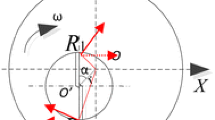Abstract
The control of cutting energy parameters is essential to optimize the cutting condition during the milling process. Our previous works (Cahuc et al., Int J Adv Manuf Technol 18(9):648–656, 2001; Darnis et al. 2000) have shown the existence of the six components of the cutting mechanical actions. Thus, the influence of geometric and kinematic parameters on the six components must be quantified. Based on the experimental approach explained in our last works (Albert et al., 2008a, b), this study proposes an energetic criterion characterizing the cutting moment in orthogonal cutting condition. Then, the energy balance has to take into account the cutting moment, highlighting the utility of this criterion. Therefore, the cutting moment model proposed allows an accurate evaluation of the energy balance and the mechanical actions (forces and moments) applied to the workpiece. Consequently, the cutting parameters can be chosen in order to optimize the cutting power consumption.
Similar content being viewed by others
References
Albert G, Cahuc O, Laheurte R, Darnis P (2007) Etude expérimentale de la coupe en fraisage. In: 18eme Cong. Franç. Méca. août, Grenoble
Albert G, Cahuc O, Laheurte R, Darnis P, K’nevez JY (2008) Approche énergétique de la coupe en fraisage. In: 5eme Assises machine et usinage à grande vitesse. Nantes, France
Albert G, Cahuc O, Laheurte R, Darnis P, K’nevez JY (2008) Experimental approach to develop a six components milling cutting mode. In: 16th int. conf. manuf. syst.—ICMa’S. Romania Academy of Sciences, Bucharest. pp 15–18
Bissey S, Poulachon G, Lapujoulade F (2005) Intégration de la géométrie d’outil dans la prédiction des efforts de coupe en fraisage grande vitesse. Méc Ind 6:391–398
Cahuc O, Darnis P, Gérard A, Battaglia JL (2001) Experimental and analytical balance sheet in turning applications. Int J Adv Manuf Technol 18(9):648–656
Couétard Y 1 (2000) Caractérisation et étalonnage des dynamomètres à six composantes pour torseur associé à un système de forces. Thèse de Doctorat, Université Bordeaux
Dargnat F (2006) Modélisation semi-analytique par approche énergétique du procédé de perçage de matériaux monotithiques. Thèse de Doctorat, Université Bordeaux 1
Darnis P, Cahuc O, Couétard Y (2000) Energy balance with mechanical actions measurement during turning process. In: International CIRP seminar on improving machine tool performance. La Baule, France
Ding H, Chen SJ, Cheng K (2010) Two dimensional vibration-assisted micro-milling: kinematics simulation, chip thickness computation and analysis. Adv Mater Res 97(101):2779–2784
Fontaine M, Devillez A, Moufki A, Dudzinski D (2006) Predictive force model for ball-end milling and experimental validation with a wavelike form machining test. Int J Mach Tools Manuf 46:367–380
Garnier S (2000) Détermination de paramètres descriptifs de l’état d’usure d’outils pour le développement d’un système de surveillance automatique de l’usinage en fraisage. Thèse de Doctorat, Université de Nantes
Garnier S, Furet B (2000) Identification of the specific coefficients to monitor the cutting process in milling. In: International CIRP seminar on improving machine tool performance. La Baule, France
Laheurte R (2004) Application de la théorie du second gradient à la coupe des matériaux. Thèse de Doctorat, Université Bordeaux 1
Laporte S (2005) Comportement et endommagement de l’outil en perçage à sec: application aux assemblages aéronautiques. Thèse de Doctorat, Université Bordeaux 1
Lee P, Altintas Y (1996) Prediction of ball-end milling forces from orthogonal cutting data. Int J Mach Tools Manuf 36(9):1059–1072
Martellotti ME (1941) An analysis of the milling process. Trans ASME 63:1667
Martellotti ME (1945) An analysis of the milling process. Part II: down milling. Trans ASME 67:233
Nuninger W, Peruquetti W, Richard JP (2006) Assessment and stakes of the friction models: joining tribology and control to achieve safety in transport. In: 5th European conference on braking, vol 2. Lille, France
Paris H, Delhez C (2000) Modelling cutting force in high-speed milling. In: International CIRP seminar on improving machine tool performance. La Baule, France
Poirier J (1993) Analyse de la variance et de la régression. Plans d’expérience. Tech Ing R260:1–21
Author information
Authors and Affiliations
Corresponding author
Rights and permissions
About this article
Cite this article
Albert, G., Laheurte, R., K’Nevez, JY. et al. Experimental milling moment model in orthogonal cutting condition: to an accurate energy balance. Int J Adv Manuf Technol 55, 843–854 (2011). https://doi.org/10.1007/s00170-010-3118-0
Received:
Accepted:
Published:
Issue Date:
DOI: https://doi.org/10.1007/s00170-010-3118-0




